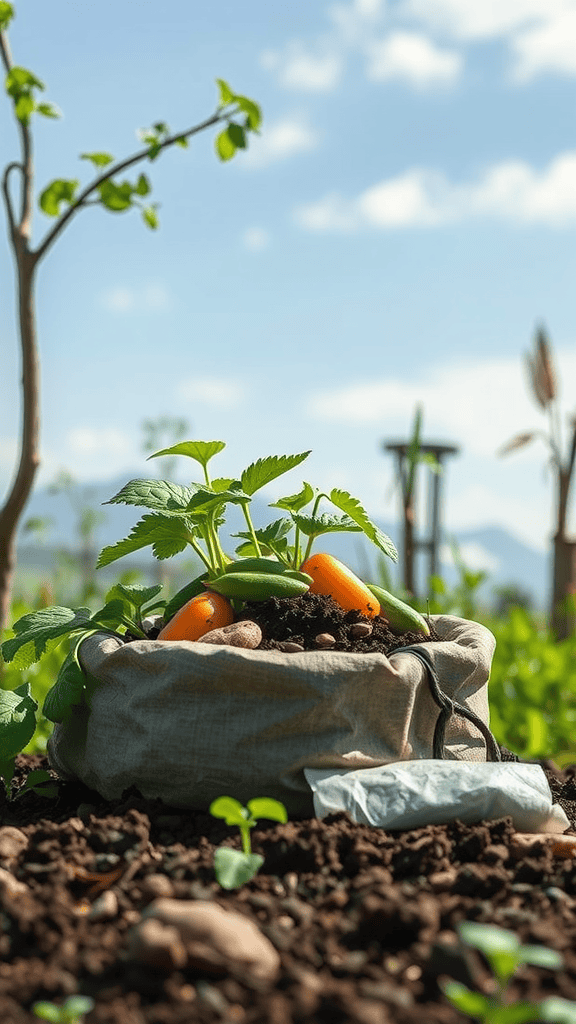Understanding Food to Power Compost: The Role of Organic Materials
Composting is a natural process that transforms organic material into rich, dark soil known as compost. It serves as an essential tool for gardeners and farmers alike, helping improve soil health and promoting sustainable practices. To understand food to power compost, it’s crucial to recognize the role of organic materials in this process.
Food scraps are vital components of compost. When you think about what organic materials to add to your compost pile, consider a variety of foods. Here are some examples:
- Fruit and vegetable scraps: Apple cores, banana peels, carrot tops, and potato skins.
- Eggshells: Rich in calcium, they benefit plant growth.
- Coffee grounds: They not only add nitrogen but also attract beneficial worms.
- Tea bags: Ensure they are made from natural fibers; they also provide nutrients.
You may wonder how these food items turn into compost. The process begins when you gather your food scraps. These scraps contribute essential nutrients to the compost pile. However, simply dumping food scraps in a bin will not suffice. To create a successful compost, you must balance “brown” and “green” materials.
Brown materials include dry leaves, straw, and cardboard. These items are rich in carbon and help aerate the compost pile, preventing it from becoming too compact. On the other hand, green materials provide nitrogen, which is abundant in food scraps and grass clippings. The right balance is necessary to keep the pile active and breaking down efficiently.
The composting process relies on microorganisms and decomposers. When you mix food to power compost, these tiny organisms, including bacteria, fungi, and worms, go to work. They feed on the organic materials, breaking them down into simpler compounds. As they consume these scraps, heat is generated, creating a warm environment that encourages further decomposition.
Time is another critical factor in this process. Depending on conditions, compost can take several weeks to several months to become usable. To speed up the breakdown, you can turn your compost pile regularly. This is where the benefits of turning your compost come into play:
- Aeration: Turning allows air to circulate within the pile, promoting the activity of aerobic microorganisms.
- Even decomposition: It helps maintain a consistent breakdown process by mixing layers and integrating fresher materials.
- Temperature control: This process helps manage heat levels, which are vital for optimal decomposition.
Once the compost is ready, you’ll notice a rich, earthy smell and a crumbly texture. This finished product is loaded with nutrients, making it an excellent addition to your garden or plants. Using food to power compost not only helps reduce waste but enriches your soil, leading to healthier plants.
In addition to food scraps, consider adding other organic materials such as grass clippings, dry leaves, and shredded paper. Each type of organic material offers unique benefits, contributing to a balanced compost mix. However, be cautious about what you add; avoid dairy, meat, and oily foods as they can attract pests and create unpleasant odors.
Understanding the role of organic materials in composting helps you appreciate its impact on the environment. By composting food scraps, you reduce landfill waste, lower greenhouse gas emissions, and create a natural fertilizer. Each small effort contributes to a larger movement towards sustainability and environmental health.
So, next time you prepare a meal, think about the scraps that would end up in the trash. Instead, leverage those kitchen leftovers to power your compost. By doing this, you are not just creating nutrient-rich soil but also participating in a significant cycle of life—one that feeds plants and fosters a healthier planet.
Comprehending the importance of food to power compost and how it works will change how you view organic waste. Start your composting journey today, and watch your kitchen scraps transform into black gold for your garden!
The Benefits of Using Food to Power Compost for Sustainable Gardening
As you explore sustainable gardening, one innovative technique you might come across is using food to power compost. This method not only helps reduce food waste but also enriches your garden soil. In this guide, let’s delve into how this practice aids in creating a healthier garden ecosystem.
Understanding Food-Powered Composting
Food-powered composting refers to the method of using kitchen scraps, garden waste, and other organic materials to create compost. This compost serves as a nutrient-rich amendment that can enhance soil health and benefit plant growth. Instead of tossing food items in the trash, which contributes to landfill waste, you can transform them into valuable compost.
Benefits of Using Food in Composting
- Nutrient-Rich Soil: Food scraps, including vegetable peels, fruit cores, and coffee grounds, are loaded with essential nutrients. These materials break down into compost, providing your plants with the nutrients they need to thrive.
- Enhanced Soil Structure: compost into your garden improves soil structure. It creates a looser, aerated environment beneficial for root development. Healthy soil also retains moisture better, reducing the need for frequent watering.
- Reduced Landfill Waste: Sending food waste to landfills contributes to methane emissions, a greenhouse gas. By composting, you actively participate in reducing your carbon footprint and promoting sustainability.
- Natural Pest Repellant: Some food scraps, especially citrus peels, can repel certain garden pests. Using these scraps in your compost can deter unwanted visitors from your plants, keeping them healthy and thriving.
- Cost-Effective Fertilizer: Homemade compost is a fantastic alternative to chemical fertilizers. It enables you to save money while providing your plants with all-natural nourishment.
How Does Food-Powered Composting Work?
Composting with food involves a natural process of decomposition. Here’s a simple breakdown of how it functions:
- Collection: Begin by collecting food scraps. Kitchen waste like fruit and vegetable peels, eggshells, and coffee grounds are excellent choices. Ensure you mix in yard waste, such as grass clippings and leaves, for balance.
- Layering: When building a compost pile, layer green materials (nitrogen-rich, like vegetable waste) with brown materials (carbon-rich, like dry leaves). This balance is crucial for efficient composting.
- Moisture and Aeration: Keep your compost pile moist but not overly wet. Turn the pile every few weeks to aerate it. This practice speeds up the decomposition process and prevents odor.
- Decomposition: As microorganisms and worms break down the organic matter, the compost will heat up. This heat is essential as it helps kill off seeds and pathogens, yielding high-quality compost.
- Harvesting: After several weeks to months, when the compost is dark, crumbly, and earthy-smelling, it’s ready to be harvested.The result is nutrient-rich compost that you can add to your garden beds.
Tips for Successful Food-Powered Composting
- Variety is Key: Use a diverse mix of materials, including fruits, vegetables, coffee grounds, and yard waste, to create a balanced compost.
- Watch for Odor: If your compost starts smelling bad, it may be too wet or lack aeration. Turning it regularly can help fix this issue.
- Avoid Certain Foods: Some items, like meat, dairy, and oily foods, should be avoided as they can attract pests and create unpleasant smells.
- Consider Worm Composting: If space is limited, consider vermicomposting, which uses worms to help break down food scraps into compost faster.
By using food to power your composting efforts, you not only contribute to a healthier garden but also participate in a larger environmental movement. This practice can lead to more fruitful yields in your garden while promoting sustainable living. Embrace the benefits of food-powered composting and watch your garden thrive!
Conclusion
As we explore the concept of food to power compost, it becomes clear that organic materials play a vital role in transforming waste into nutrient-rich soil amendments. By understanding how these materials break down, you can become an active participant in reducing landfill waste while enriching your garden. The process not only enhances soil health but also fosters sustainable gardening practices that benefit the environment and your plant growth.
Using food to power compost offers numerous advantages for your gardening endeavors. It allows you to recycle kitchen scraps, thereby minimizing waste and cutting down on harmful emissions from decomposing waste in landfills. Additionally, the nutrients generated from this compost bolster soil fertility, leading to healthier plants that thrive with less need for chemical fertilizers.
Engaging in this eco-friendly practice also nurtures a sense of community and environmental responsibility. As you share your composting journey with neighbors or friends, you contribute to a larger movement towards sustainability. Embracing food to power compost not only revives your garden but also empowers you to participate in a greener, healthier planet.
With each handful of compost, you are not just improving your garden but also making a positive impact on the world around you. So gather those kitchen scraps, start composting, and witness the remarkable transformation of waste into life-giving soil for your plants. By doing so, you pave the way for a more sustainable future for generations to come.
As an Amazon Associate, I earn from qualifying purchases.

